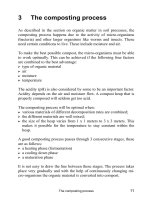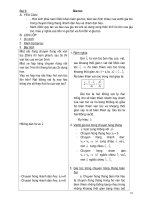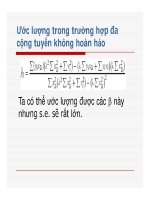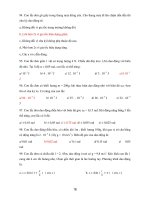Environmental and Quality Systems Integration - Part 2 ppsx
Bạn đang xem bản rút gọn của tài liệu. Xem và tải ngay bản đầy đủ của tài liệu tại đây (146.05 KB, 9 trang )
©1998 CRC Press, LLC
Part II
Integrating The Policy
5
©1998 CRC Press, LLC
The Policy
5.1 INTRODUCTION
Having spent time in the first four chapters laying down a foundation for the
integration process, we can now begin to focus our attention on the actual process
itself. In this chapter and the next several to follow, we will use the major ISO 14001
elements (Policy, Planning, Implementation and Operation, Checking and Corrective
Action, and Management Review) as a base to be built upon as we go through this
process. For instance, this chapter will use ISO 14001
Element 4.2
, Environmental
Policy, as the starting point and then see how various quality systems can be
integrated with it.
Each of these chapters will be organized in a similar format which will include
an evaluation of the various Quality Management System and Environmental Man-
agement System requirements, what a combined management system can or might
look like, and what an auditor might look for if a joint QMS and EMS audit were
conducted. Each requirement will be dissected in order to provide a better overall
picture to view the integration process. Additionally, any differences that cannot be
integrated will be discussed.
In Appendix B, I have provided a very detailed table that shows the cross-
referencing between ISO 9001 and ISO 14001. This table will provide the primary
foundation for the integration being discussed in the following chapters. In addition,
Appendix C shows a comparison of the two ISO standards, British Standard 7750,
and the Eco-Management Audit Scheme.
5.2 ISO 9001 REQUIREMENTS
The U.S. Automotive requirements for ISO 9001, QS-9000, will be evaluated pri-
marily in conjunction with ISO 9001 and will, on occasion, be evaluated separately
for specific QS-9000 requirements as they come up. In the case of establishing a
policy, there are not separate requirements between the two standards. The require-
ments for a quality policy are found under Section 4.1,
Management Responsibility
:
Section 4.1.1 of ISO 9001 states:
The supplier’s management with executive responsibility shall define and document
its policy for quality, including objectives for quality and its commitment to quality.
The quality policy shall be relevant to the supplier’s organizational goals and the
expectations and needs of its customers. The supplier shall ensure that this policy is
understood, implemented and maintained at all levels of the organization.
©1998 CRC Press, LLC
In order to better understand what this requirement means and to ensure good
compliance during an audit of an integrated policy, let’s dissect it and highlight its
various subcomponents:
The supplier’s management with executive responsibility shall define and
document its policy for quality, including:
•
objectives
for quality,
and its commitment to quality. The quality policy shall be:
• relevant
to the supplier’s organizational
•
goals
and the
•
expectations
and
needs
of its customers.
The supplier shall ensure that its policy is:
• understood,
• implemented, and
• maintained
at all levels of the organization.
You will note that there are eight specific sub-requirements built into the overall
Element 4.1.1
. The reason for breaking this requirement down in such a manner
will become evident when we look at ISO 14001’s requirements.
5.3 ISO 14001 REQUIREMENTS
Element 4.2 of ISO 14001 states:
Top management shall define the organization’s environmental policy and ensure that
it: (a) is appropriate to the nature, scale, and environmental impacts of its activities,
products, or services; (b) includes a commitment to continual improvement and
prevention of pollution; (c) includes a commitment to comply with relevant environ-
mental legislation and regulations, and with other requirements to which the organi-
zation subscribes; (d) provides the framework for setting and reviewing environmental
objectives and targets; (e) is documented, implemented and maintained and commu-
nicated to all employees; and, (f) is available to the public.
In a similar manner, let’s dissect the subrequirements of this element:
Top management shall define the organization’s environmental policy and
ensure that it is appropriate to the:
• nature,
• scale, and
• environmental impacts,
©1998 CRC Press, LLC
and its activities, products or services; includes a commitment to:
• continual improvement and
• prevention of pollution;
includes a commitment to comply with:
• relevant environmental legislation and regulations, and
• with other requirements
to which the organization subscribes; provides the framework for:
• setting and reviewing environmental
objectives
and
targets
;
is:
• documented,
• implemented,
• maintained, and
• communicated
to all employees; is:
• available to the public
At first glance the requirements for ISO 14001 appear to be much greater than
ISO 9001, when, in fact, they are very similar. Before we proceed with a side-by-
side comparison of the two standards, it is important to discuss three very important
differences found in ISO 14001.
5.4 POLICY DIFFERENCES
In the policy requirements for
Element 4.2
of ISO 14001, there are three items
which do not appear in ISO 9001, but will have to be specifically included in an
overall integrated policy: (a) the commitment to continual improvement; (b) the
commitment to prevention of pollution; and (c) commitment to legal and other
requirements. The inclusion of these in any policy, whether strictly environmental,
quality, or operational in nature, must be fully understood, because of the ramifica-
tions to the resulting system and what auditors may end up evaluating as part of the
audit scope.
5.4.1 C
ONTINUAL
I
MPROVEMENT
What is meant by continual improvement and what is its potential impact on
your management system if included in a policy statement? Section 3.1 of ISO 14001
defines continual improvement as a:
process of enhancing the environmental management system to achieve improve-
ments in overall environmental performance in line with the organization’s environ-
mental policy.
©1998 CRC Press, LLC
Additionally, Section 4.5.3 of ISO 14004,
Environmental Management
Systems
— General Guidelines
, states:
The continual improvement process should … identify areas of opportunity for
improvement of the environmental management system which leads to improved
environmental performance.
Although this may sound confusing at first, a closer inspection of these state-
ments clearly shows that better environmental performance will be a result of the
system’s continual improvement process. Although this is an ISO 14001 require-
ment, there are practical benefits to be gained by a quality management system from
a commitment to continual improvement. After all, what business doesn’t want to
continually improve its processes and the overall quality of its product? Although
Element 4.1.1
of ISO 9001 does not require this in the policy, you will see in a later
section of this chapter, that it does contain foundational requirements to drive the
continual improvement process. To use an analogy, both ISO 14001 and ISO 9001
policy statement requirements contain the “fuel” necessary to drive the continual
improvement “engine.” Thus, although the two standards differ in the requirement
to state a “commitment to continual improvement,” both also contain all of the
necessary ingredients to improve performance through a continual improvement
process. It is my opinion that the commitment to “continual improvement” in any
policy can provide the basis for a better management system and will result in a
significant impact on your operations’ performance.
Although ISO 9001 does not contain this specific requirement, it is important
to note that a continuous improvement “philosophy” is required under Section 2,
Sector-specific Requirements
, of QS-9000. Sector 2.1 states: “A comprehensive
continuous improvement philosophy shall be fully deployed throughout the sup-
plier’s organization …” Thus, continuous improvement becomes part of your basic
organizational policy “by default.”
5.4.2 P
REVENTION
OF
P
OLLUTION
The inclusion of this requirement in ISO 14001 is one of the two primary
differences from ISO 9001. However, as with the case of continuous improvement,
QS-9000 is much more definitive in Section 4.9,
Process Control
. Again, prevention
of pollution should become part of your organizational policy by default. ISO 9001
states:
A supplier shall have a process to ensure compliance with all applicable government
safety and environmental regulations, including those concerning handling, recycling,
eliminating, or disposing of hazardous materials …
The inclusion of this requirement was driven by the United States Environmental
Protection Agency and created much debate over the difference between “pollution
prevention” and “prevention of pollution” — this distinction must be clearly under-
stood in order to ensure that the implementation of the management system clearly
meets the ISO 14001 requirements. The U.S. EPA defines “pollution prevention” as
©1998 CRC Press, LLC
“the use of materials, processes, or practices that reduce or eliminate the creation
of pollutants or wastes at the source. It includes practices that reduce the use of
hazardous materials, energy, water, or other resources and practices that protect
natural resources through conservation or more efficient use.” It’s basic effort is to
avoid the generation of pollutants throughout a process. In contrast, ISO 14001
defines “prevention of pollution” as “the use of processes, practices, materials, or
products that avoid, reduce, or control pollution, which may include recycling,
treatment process changes, control mechanisms, efficient use of resources, and
material substitution.” The standards are thus more concerned with how an organi-
zation manages its actual or potential pollutants. This particular definition won out
because, as a generic international standard, many nations have neither the resources
nor the capability in their manufacturing processes to avoid generating environmental
pollutants — initial efforts have to focus on controlling the pollutants already gen-
erated and, hopefully, over time move towards “pollution prevention.”
5.4.3 C
OMMITMENT
TO
L
EGAL
C
OMPLIANCE
AND
O
THER
R
EQUIREMENTS
The third and final difference which must be addressed in the policy between
ISO 14001 and ISO 9001 concerns compliance to regulations and any other require-
ments which your organization must adhere to (i.e., Responsible Care
®
, API, etc.).
Although the policy requirements under ISO 9001 do not directly specify the need
to commit to this, the standards as a whole do require a process to ensure legal
compliance.
In ISO 9001, Section 4.9,
Process Control,
states:
A supplier shall have a process to ensure compliance with all applicable government
safety and environmental regulations, including those concerning handling, recy-
cling, eliminating, or disposing of hazardous materials …
Again, as in the case of continual improvement and prevention of pollution, legal
compliance should become part of your organizational policy by default.
I would like to point out one major difference, however, between what
ISO 14001,
Element 4.2
,
Environmental Policy
, requires and the above stated
requirement under Section 4.9,
Process Control
, of ISO 9001. Specifically,
Section 4.9 of ISO 9001 requires “a process to
ensure
compliance…” whereas
ISO 14001’s policy requirements are to “include a
commitment
to comply…” What
ISO 14001 is
not
requiring is “compliance to regulations.” In fact, as we look in a
later chapter into ISO 14001,
Element 4.3.2
,
Legal and Other Requirements
, you
will see that what is needed is a procedure to assist in identifying all legal and other
requirements — it neither “guarantees” nor requires compliance. What we then face
in writing the policy is a decision to include some statement which addresses the
regulatory arena and any other standards, codes, etc. which you may or may not
have to adhere to. Since the policy becomes the starting point for an auditor, it thus
becomes critical to not include statements which are too “specific.” It is highly
recommended that the requirement under ISO 14001 be followed as written: “… a
commitment
to comply …” One should avoid any definitive statements such as: “We
©1998 CRC Press, LLC
will establish procedures to
ensure
compliance…” As one OSHA inspector told me:
“You can never be in 100% compliance!” So don’t commit to it in a policy!
5.5 OTHER STANDARDS AND PRINCIPLES
As you begin to think about what your organization policy will look like, it is highly
recommended that you benchmark other organizations and standard-making bodies.
Although you will have some business-specific requirements which you may want
to include in your policy, there is no sense in “reinventing the wheel.”
In some of the preceding chapters, I have provided some sources of information
which can be used in your own policy. They include Deming’s 14 Points for
Management, API’s Environmental Principles, and the Guiding Principles of
Responsible Care
®
. In the Appendices you will find the International Chamber of
Commerce’s Charter for Sustainable Development, the Rio Declaration on Environ-
mental and Development, and the Keidanren Global Environmental Charter.
Other bench-marking sources are other companies and, especially, those which
have developed an “Operational” Policy as opposed to separate environmental and
quality policies. An Operational Policy is essentially designed to show a business’
overall management philosophy, core values, and mission in addition to satisfying
some of the requirements of ISO 14001 and ISO 9001. But an Operational Policy
can only be developed when a member from every facet of the business is involved.
5.6 DEVELOPING AN INTEGRATED POLICY
Let’s now look at how we can actually assemble an “operational” policy which will
satisfy the requirements of both ISO 14001 and ISO 9001. The best approach would
be to first look at the two standards side-by-side and see where they match and then
to write a statement that could be included in the policy. Table 5.1 shows a compar-
ison of the two standards.
What needs to be done now is to begin formulating statements which: (1) reflect
the common requirements; (2) address the requirements specific to ISO 14001; and
(3) which can be edited in such a way as to generate a policy you would be satisfied
with for public display.
The following statements can be used as examples:
• Our primary
goals
are to achieve complete customer satisfaction and to
be recognized as an outstanding environmental citizen.
• Our primary
goal
is to meet the
expectations
and
needs
of our customers
and the neighboring community through the use of effective
quality
improvement teams
and
environmentally sound
management practices.
• We will achieve this goal by establishing
objectives
which will standard-
ize, control, and
continuously improve
our operations.
• Our
goal
is to provide quality products, goods, and services which meet
the
expectations
and
needs
of our customers through the use of
environ-
mentally sound
management and technologies.
©1998 CRC Press, LLC
• We shall provide products, goods, and services to our customers which
are made (manufactured) to meet their
expectations
, and in a manner
which meets all
regulations, industry standards, and other requirements
.
• Through the establishment of annual
objectives and targets
we will strive
to
continuously improve
our operations.
• We will
continuously improve
so as to provide our customers with a quality
product, to
prevent pollution
, and minimize the environmental impact of
our operation.
• We will
communicate
this policy to all of our employees and make it
available to the
public
, as a means to ensure their
understanding
, com-
mitment, and active involvement in achieving our
objectives and targets
.
A combination of these statements or variations would meet the policy require-
ments found under the two ISO standards. With the exception of Akzo Nobel
Chemicals, Inc., most companies do not have an integrated policy.
5.7 WHAT AUDITORS WILL LOOK FOR
The policy forms the foundation from which you build your management system
and is, obviously, the starting point for an auditor. Besides the specific requirement
to include
continual improvement
,
legal and other requirements
, and
prevention of
pollution
, an auditor is mainly concerned about how the policy plays out through
the system. Since a policy must be relevant to the nature and scale of your business,
it is up to the auditor to determine if this, in fact, is so.
TABLE 5.1
Correlation of Policy Requirements
Element 4.1.1 — ISO 9001 Element 4.2 — ISO 14001
objectives
for quality environmental
objectives and targets
relevant
nature
scale
goals
environmental
objectives and targets
expectations
and
needs
of its customers
other requirements
understood
communicated
implemented
implemented
maintained
documented
maintained
continual improvement
prevention of pollution
relevant environmental legislation regulations and other
requirements
available to the public
©1998 CRC Press, LLC
Some key things to remember: (1) make sure the policy is understood by your
employees since their job functions must ensure compliance to it; (2) make sure the
policy is available in as many ways as possible such as in training modules, rule
booklets, on walls, at meetings, etc. — an auditor does not expect an employee to
recite the policy by heart, but they must have a basic understanding of its contents
and how it applies to their particular job function; and (3) make sure the policy is
available to visitors, your neighbors, local agencies, etc. — use your customer service
group as a vehicle to make it available.
5.8 CONCLUSION
In this chapter, my intent was not to write a policy for you, but to provide examples
which can be incorporated into a policy that meets your expectations or is relevant
to the nature and scale of your business.
If any part of your policy does not satisfy the ISO 14001 requirements, then the
systems which are derived from it are lacking the vehicle which gives them “cred-
ibility.” You can probably avoid “
hold
” points in other parts of the audit, but to
encounter one right at the opening session could be very disheartening and take the
“wind out of your sails.”
In Appendix H, a figure which the interrelationship of the various ISO 14001
elements. You will note that the contents of your policy can be influenced by the
ISO 14001 Standards themselves, but also by the applicable regulations, industry
standards, codes of practice, your customers, the public, and so on. As you begin
to formulate the contents of your operational policy, it is important to broaden the
“scope of influences” on your business.









